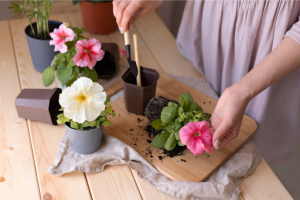Introduction
Violet flowers are beautiful, delicate plants known for their vibrant purple shades and sweet scent. This comprehensive guide to violet flowers will take you on a journey through their different varieties, how to grow and care for them, and the special symbolism they hold in various cultures. Violets are more than just pretty flowers; they’ve been loved by people for centuries and often symbolize love, loyalty, and humility.
There are many types of violets, from the common garden violet to the unique African violets, each adding a special touch to gardens or homes. They grow well in cool, shaded areas and need just the right care to thrive. With this guide, you’ll learn fun facts and easy steps to plant, water, and protect violets, making it simple for anyone—even a beginner gardener—to enjoy these charming flowers year-round.
Violet Flower Varieties: An Overview of Different Types
Violet flowers come in many types, each with its own unique look and personality. From wild violets to sweet-smelling garden varieties, these plants can add color and charm to any space. Some of the most popular types include the common blue violet (Viola sororia), often found growing in lawns and fields, and the sweet violet (Viola odorata), known for its lovely fragrance. Then there’s the African violet, which is popular as a houseplant because of its small size and ability to bloom indoors.
Each variety has its own needs for sunlight, water, and soil to stay healthy. Wild violets can thrive outdoors with little care, while African violets need warmth and regular watering. By understanding the differences between these types, you can choose the perfect violet for your garden or home, bringing nature’s beauty and charm into your life easily.
The Growing Conditions for Violet Flowers
Violet flowers are easy to grow if you provide the right growing conditions. These plants prefer cool, shady areas and thrive best in soil that is rich and slightly moist. Direct sunlight can be too strong for violets, so placing them in partial shade keeps their blooms vibrant and healthy. For the soil, make sure it drains well, as violets don’t like their roots to stay too wet. If you’re growing African violets indoors, they’ll need a warm spot with indirect light, like near a window with filtered sunlight. To keep the soil moist, water them gently without soaking the leaves. Adding a light layer of mulch can also help the soil retain moisture. With a little attention to shade, warmth, and water, you can create perfect growing conditions for violet flowers and enjoy their lovely blooms in your garden or home all year round.
Step-by-Step Guide to Planting and Propagating Violets

Planting and propagating violets is simple and fun! First, choose a spot with partial shade for outdoor violets or a sunny windowsill for indoor African violets. Start with rich, well-draining soil to help them grow strong roots. To plant violet seeds, press them gently into the soil without burying them too deep, and keep the soil moist but not too wet.
For quicker results, try propagating violets by gently removing a leaf with its stem from an existing plant. Place the stem in a small pot with moist soil, covering it lightly. Within a few weeks, tiny roots will start to grow. Keep young plants in a warm area and avoid too much direct sunlight. Remember to water sparingly, as violets don’t like soggy soil. Following these simple steps for planting and propagating violets, you’ll soon enjoy a lovely patch of these charming flowers right at home!
Care and Maintenance: Ensuring Healthy Violets
Taking care of violets is easy with a few simple steps to keep them healthy and blooming! Violet flowers love slightly moist soil, so water them carefully without soaking the leaves—too much water can lead to rot. It’s best to water at the base of the plant, letting the soil absorb moisture slowly. Place violets in partial shade or indirect sunlight, as too much direct sun can damage their delicate leaves.
For indoor African violets, a warm spot with filtered light is perfect. Feeding them with a mild fertilizer every few months helps them grow strong. Also, watch out for pests like aphids and gently remove any damaged leaves to prevent spreading. To encourage more blooms, trim back any old flowers and leaves, making room for fresh growth. By following these simple care and maintenance tips, your violets will stay vibrant and healthy all year, bringing beautiful color to your space!
Symbolism and Cultural Significance of Violet Flowers

The symbolism and cultural significance of violet flowers is rich and meaningful. In many cultures, violet flowers stand for loyalty, love, and humility. They’re often seen as symbols of modesty because of their delicate blooms that don’t try to stand out too much. In ancient times, violets were linked to love and remembrance. People believed that giving violets could show true feelings of care and friendship.
In art and literature, violets are often used to represent peaceful, calming emotions or a gentle beauty. The color purple itself is also important—it’s linked to royalty, wisdom, and creativity. So, violets can also carry a feeling of dignity and respect. Whether in gardens or as gifts, violets bring more than just beauty; they also share messages of kindness and devotion that make them special across the world.
FAQ’s
What are some popular types of violet flowers?
Common types include sweet violets, African violets, and common blue violets.
Where do violet flowers grow best?
They thrive in cool, shaded areas with moist, well-draining soil.
Can I grow violets indoors?
Yes, African violets are popular indoor plants and need indirect light.
How often should I water my violets?
Water them when the topsoil feels dry, avoiding excess water on the leaves.
Do violets need direct sunlight?
No, violets prefer indirect or partial shade; direct sunlight can harm them.
What do violet flowers symbolize?
Violets symbolize love, loyalty, humility, and remembrance.
Conclusion
In conclusion, violet flowers are more than just beautiful plants; they are symbols of love, loyalty, and peace. With this comprehensive guide to varieties, cultivation, and symbolism, you now know how to grow and care for violets in any setting—whether in a garden or a cozy indoor pot. From picking the right soil and sunlight to learning the best way to water and protect them, growing healthy violets can be easy and rewarding.
These charming flowers can brighten any space while bringing a sense of calm and meaning with their rich symbolism. Whether you choose wild violets or African violets, their gentle blooms will remind you of nature’s beauty and inspire feelings of kindness and connection. Start planting violets today to enjoy their beauty and unique symbolism all year round, making them a cherished addition to your garden or home.

